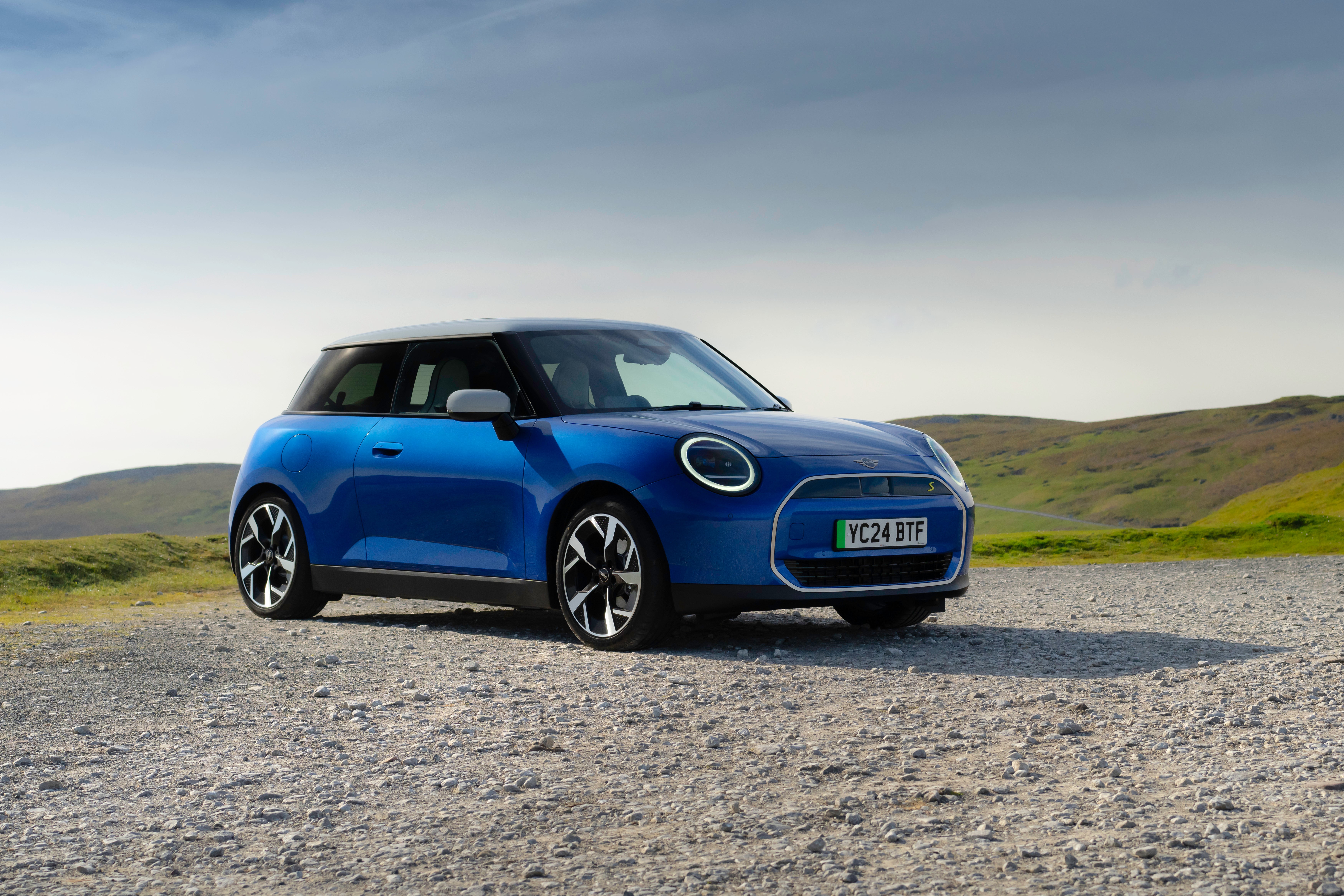The Seriously Fun Electric Mini Cooper Returns—but There’s a Problem

Despite its familiar looks, the new Mini Cooper has just undergone its biggest update this century. The ionic headlights, white roof, and city-friendly dimensions remain, as they have throughout BMW’s two decades at the helm of the Mini brand. But under that familiar skin, it’s all-new.
For starters, the 2024 Mini Cooper sits on a new electric platform. It has more range and straight-line performance than its predecessor, plus an all-new interior that boasts more tech and more space, despite the exterior being slightly shorter (but a little wider) than before.
That new platform comes from a partnership between BMW and Great Wall Motor, the Chinese firm whose catalog of EV brands includes Ora, makers of the unremarkable and unrelated 03 (née Funky Cat). The new electric Cooper is made in China, with extra production to commence in Oxford, England, in 2026. Only then might the car head to North America, since it will no longer fall victim to import tariffs imposed on Chinese-built EVs.
In addition to a new platform, there’s new nomenclature to get your head around: All versions of the smallest Mini are now called “Cooper.” This includes the electric Cooper E and higher-performance Cooper SE, both reviewed here, but also the internal-combustion Cooper C and Cooper S, which are available in a three- or five-door configuration.
Cooper SE: 0 to 62 mph in 6.7 seconds
Photograph: Mini USA
Cooper E: 0-62 mph in 7.3 seconds
Photograph: Mini USA
Although also “new,” those ICE versions sit atop the old platform, and are more heavily facelifted than truly all-new. If the Cooper is too small for you, there’s the equally new (and electric-only) Mini Aceman, or if you need even more space there’s the range-topping Mini Countryman, which is offered with both gas and electric drivetrains.
All clear? Good. Actually, no, one more thing: Mini doesn’t make a hot John Cooper Works version of its EV hatchback—at least not yet, anyway. So while the SE driven here was positively dripping in JCW kit, this is all available from the options catalog, and changes nothing about the car’s performance. Adds plenty to the price, mind you, but we’ll come back to that later.
Extra Mini Miles
The new electric Mini has a lot more range than the previous model.
Photograph: Alistair Charlton
WIRED drove both the standard Cooper E and quicker Cooper SE. The base car is powered by a 135-kW (181-hp), 290-Nm (214-foot-pound) motor driving the front axle. Mini claims a 0-62 mph time of 7.3 seconds, a top speed of 105 mph, and a range of up to 190 miles from the 36.6-kWh battery, using the WLTP standard. It also claims an electric consumption of 4.4 miles per kWh. For context, the previous generation of Mini EV claimed a circa-140 mile range from its 28.9-kWh pack.
Prices in the UK, where this test drive took place, start at £29,420 including tax ($37,300 at the time of writing). The car we drove also included the Level 1 kit, which feels worthwhile at £2,000 and includes folding mirrors, heated front seats, adaptive LED headlights with high-beam assist, a head-up display, and wireless phone charging.
The sportier Cooper SE starts at £33,920 (about $43,000) and is upgraded in almost every way. The motor sends 160 kW (215 hp) and 330 Nm (243 foot-pounds) to the front wheels, accelerating the car to 62 mph in 6.7 seconds and to a top speed of 112 mph. The larger battery has a usable capacity of 49.2 kWh and a claimed WLTP range of up to 250 miles. It also charges more quickly, with a maximum rate of 95 kW, compared to just 75 kW for the Cooper E. Though, it must be said, neither charge speed is particularly impressive—both will take around 30 minutes to fill from 10 to 80 percent on a high-speed DC charger. Claimed efficiency for the SE is 4.2 miles per kWh.
Head to the options list and, as ever with Mini, there’s plenty to relieve you of your cash. The fully-loaded Cooper SE we drove had Mini’s Level 3 kit, which costs £4,500 and includes a panoramic roof, massage function (but only for the driver), a Harman/Kardon sound system, cellular connectivity, and augmented reality navigation. The latter shows a camera view on the touchscreen with virtual arrows laid over it—a clever use of tech, granted, but since the display is off to the side of your eye line, not the most useful. It also means the system prompts you to look at the screen and away from the road precisely when you shouldn’t be.
High Price for Smart Looks
WIRED is a fan of the tweaked external design on the new Mini EV, but the body-kit extras are costly.
Photograph: Mini USA
Add on the sporty John Cooper Works body kit and the total cost comes to £42,470 ($53,800). Yes, you’re looking at a Mini Cooper costing more than $50,000. BMW has always smartly presented the Mini as a premium car that just happens to be small—and, to its credit, it has done so with great success for more than 20 years. But unless money really doesn’t matter to you, we suggest you at least drop the £3,500 of JCW trinkets fitted to our test car. A proper JCW with performance to match the styling should be along later.
Aesthetics are subjective, of course, but we’re big fans of the way the new Mini Cooper looks in standard form. Gone are the black plastic wheel arch trims of all previous BMW models, creating a cleaner, more premium look, while the octagonal mouth appears more like a grille and less like an ill-advised mustache. The new taillights work well, too, at least to our eyes, and while their design is still inspired by the Union flag, it’s more of a passing nod than a salute, thankfully.
The bright yellow, blue, green, and red paint options are a welcome change to the sea of gray offered by most car companies, while the flush door handles look smart, and chrome has been entirely removed, both inside and out.
The bright yellow details of the old plug-in Mini have also been cast aside, along with the wheels designed to look like the UK’s three-pin plug socket. This is no longer a car trying to shout about its electric credentials. It is instead a Mini Cooper that just so happens to be electric.
Interior Overhaul
The new interior finally boasts properly circular OLED touchscreen.
Photograph: Mini USA
Inside, the cabin has undergone a significant overhaul. The biggest talking point is, of course, the circular, 9.5-inch OLED touchscreen on the center of the dash. We don’t need us to remind you it’s inspired by the circular speedometer of the 1959 original, but it means that finally—finally—Mini can stop forcing a rectangular infotainment display into a circular hole.
We’d all grown used to it, but you get the feeling Mini wishes it could have installed a circular touchscreen years ago. Now it finally has, and while the technology fan in us can’t help but smile at the OLED goodness, it sadly isn’t the most intuitive of infotainment systems.
No physical climate controls is a minus, and the UI in general take some getting used to.
Photograph: Mini USA
As is so often the case with today’s cars, you’ll need to spend a couple of hours rewiring your brain before using the interface becomes instinctive. For starters, there are no longer any physical climate controls. Instead, a control panel beneath the display houses a volume knob, a gear selector, a keylike switch that turns the car on or off with a twist, and a toggle for flicking between the seven drive modes. Cabin temperature is adjusted by tapping or swiping at the permanently-displayed icons on the screen, or by voice command. It’s fiddly, but you get used to it.
Although each drive mode (or “experience” as Mini insists on calling them) changes the look of the screen, fundamentals such as your speed, gear, and the local speed limit stay in place at the top. Navigation occupies a circular window in the center, and a panel of shortcut buttons permanently reside at the six o’clock position.
The interface is slick and responsive, while the OLED panel means colors are vibrant and blacks are truly black. There’s a real sense of fun here, once you’ve worked it all out, and we’re sure some Mini fans will love how the screen turns retro in Timeless mode, complete with sepia-toned dials and a vintage font.
Go-kart mode gives a sporty look to the dials and amps up the car’s artificial soundtrack. Played in the cabin, this sci-fi whirr won’t be for everyone, but it adds to the sense of speed. Mini has clearly put some thought into it, right down to how there’s the synthetic sound of a turbo wastegate fluttering when you lift off the accelerator.
Similarly amusing is how the soundtrack in Timeless model is meant to sound like an original Mini. It won’t quite turn your commute into a scene from The Italian Job, but it’s still another sign that this car wants you to have fun, and doesn’t take itself too seriously. Also, mercifully, the way it yells “woo-hoo” every time you select go-kart mode can be switched off.
Wireless Apple CarPlay and Android Auto are both here, but appear in a square in the center of the screen, with the climate controls, fuel level, speed, and shortcut buttons sat in their usual positions around the outside. It’s a little jarring and clearly not as seamless as Mini’s own system, but we like how your CarPlay wallpaper extends to the entire screen, and that the UI’s key controls remain accessible regardless of what your iPhone is doing.
The cabin is spacious with plenty of room in the back.
Photograph: Mini USA
While that all takes a bit of learning, the rest of the paired-back cabin is a triumph. The recycled knitted fabric on the top of the dashboard and door panels is particularly nice, as is how colored light projects onto it from behind the touchscreen. It lacks the welcoming softness of your favorite sofa, but it’s far more visually pleasing than plastic or synthetic leather.
There’s a good amount of storage between the front seats, including a small cubby for hiding valuables. We also like the set of tactile buttons on the steering wheel, and behind that you’ll find a set of conventional stalks for the lights and wipers. You could accuse us of stating the obvious there, but in a dimwitted world of stalkless Teslas, Mini’s more logical approach is worth highlighting.
Also of note is how spacious the Cooper’s cabin feels. Light floods in through the optional glass panoramic roof, and there’s more space in the back than you might expect. Granted, 6-foot adults won’t enjoy long journeys back there, but there’s a surprising amount of head room. The trunk is small, of course, but it’s slightly more spacious than the Fiat 500e, and no one buys a three-door Mini to haul more than a small carry-on case or two.
Drive Tribe
Instead, people buy Minis because of how they drive. These have always been cars bursting with personality, and for this latest iteration the charisma still comes pouring out.
The SE is noticeably quicker off the line than the E, but once up to speed there’s surprisingly little to tell the two apart. Both playfully tug at the steering wheel when accelerating out of tight corners, the front wheels following the camber of the road as they scramble for grip.
The uneven, narrow, and winding UK country lanes on this brand-hosted test are exactly where Minis are supposed to be enjoyed. They highlight the firmness of the ride (which isn’t always entirely welcome), but encourage you to engage go-kart mode and have some fun without risking your license.
Around town and in country lanes, the steering is quick and the front end has lots of grip.
Photograph: Mini USA
Here, the Mini Cooper is a car that puts a smile on your face. Purists will argue that isn’t possible without three pedals, a gear stick, and an engine, but we beg to differ. The compact dimensions mean you can place the car precisely in your lane, the steering is quick and the front end has lots of grip.
One-pedal driving is enabled via the gear selector, and it works, slowing the car as you lift the accelerator and pumping regenerated energy back into the battery. Paddles on the steering wheel to adjust the regen strength would be welcome, but Mini has decided to keep things simple.
Sedate Charging
In a world where car manufacturers mistakenly believe EVs can excite only if they use 600 horsepower to make the driver nauseous at every opportunity, the Mini Cooper is a breath of fresh air. It’s fun, characterful, and doesn’t need a sledgehammer blow of torque to entertain.
It’s relatively efficient, too. During a “spirited” 90-minute drive in the quicker SE we saw an average consumption of 3.7 miles per kWh. This falls short of Mini’s claim of 4.2, but we weren’t on an economy run. Multiplied by the usable battery capacity, this gives an estimated real-world range of 182 miles, without accounting for mileage earned back by regenerative braking. Now that’s well short of Mini’s 241-mile claim, but is almost exactly equal to the 188 miles our test car estimated it could achieve when fully charged.
The less powerful Cooper E managed 4.1 miles per kWh, equating to a real-world range of 150 miles before accounting for regen braking. That’s 35 miles short of the WLTP claim, but still an improvement on the circa-100 miles of its predecessor. That said, even the best-case range is less than European rivals like the Peugeot e-208 and Vauxhall Corsa, and they charge more quickly, too.
The longer legs of the new Mini are a welcome upgrade over the previous generation, especially since the compact size, agile handling, and fun remain perfectly intact. But this still isn’t a car built to take long journeys in its stride, and that’s a problem compounded by relatively slow charging.
If Mini had delivered a charge rate closer to 150 kW—for context, the cheaper MG4 manages 135 kW—then this wouldn’t be such a concern. But at 95 kW for the SE and just 75 kW for the entry-level E, the new Cooper remains an EV that, while huge fun and packed with character, is still unlikely to venture far from home.




